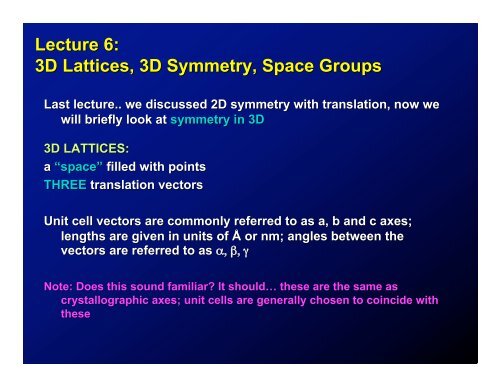Lecture 6: 3D Lattices, 3D Symmetry, Space Groups
Lecture 6: 3D Lattices, 3D Symmetry, Space Groups
Lecture 6: 3D Lattices, 3D Symmetry, Space Groups
You also want an ePaper? Increase the reach of your titles
YUMPU automatically turns print PDFs into web optimized ePapers that Google loves.
<strong>Lecture</strong> 6:<br />
<strong>3D</strong> <strong>Lattices</strong>, <strong>3D</strong> <strong>Symmetry</strong>, <strong>Space</strong> <strong>Groups</strong><br />
Last lecture.. we discussed 2D symmetry with translation, now we<br />
will briefly look at symmetry in <strong>3D</strong><br />
<strong>3D</strong> LATTICES:<br />
a “space” filled with points<br />
THREE translation vectors<br />
Unit cell vectors are commonly referred to as a, b and c axes;<br />
lengths are given in units of Å or nm; angles between the<br />
vectors are referred to as !, ", #<br />
Note: Does this sound familiar? It should… these are the same as<br />
crystallographic axes; unit cells are generally chosen to coincide with<br />
these
<strong>3D</strong> unit cells come in the same types as 2D unit cells:<br />
PRIMITIVE UNIT CELL (P): contains one lattice point<br />
And also other types:<br />
BODY-CENTERED UNIT CELL (I): doubly primitive (2 lattice<br />
points, one extra in center of cell)<br />
END-CENTERED UNIT CELL (A; B; C): doubly primitive (2<br />
lattice points, extra 1/2 in each of two opposite faces)<br />
FACE-CENTERED UNIT CELL (F): 4 lattice points (at corners +<br />
1/2 in middle of each face)
This leads to 14 unique <strong>3D</strong> lattices (BRAVAIS LATTICES): the only possible ways in<br />
which points can be arranged periodically in three dimensions -- 6 of these are<br />
PRIMITIVE - one corresponds to each of the 6 CRYSTAL SYSTEMS
Remember, the addition of translation led to the addition of a<br />
new symmetry element, the GLIDE PLANE (glide line in 2D),<br />
in <strong>3D</strong> there is another new symmetry element created by<br />
translations, the SCREW AXIS<br />
SCREW AXIS: combination of a rotation and a translation<br />
Screw axes are always right-handed<br />
or left-handed (come in<br />
enantiomorhpous pairs)
Screw Axis Notation: rotation number with subscript to indicate fraction<br />
of a translation with each part of rotation<br />
Ex. 2 1 = 2-fold rotation, with 1/2 t in each 180° twist<br />
3 1 = 2-fold rotation, with 1/3 t in each 120° twist<br />
Convention: : fractions less than or equal to 1/2 = right-handed screw;<br />
greater than 1/2 = left-handed screw<br />
GLIDE PLANES are notated as “a”, “b” or “c” (rather than “m” for mirror)<br />
if they are parallel to the a, b, or c axes; they are notated as “n” if they are<br />
1/2 a unit cell in the ab, bc, , ac or abc direction; they are notates as “d” if<br />
they are 1/4 unit cell in the ab, bc, , ac, or abc direction
SPACE GROUPS: : symmetry in space (including translation); the various<br />
ways in which motifs can be arranged in space in a homogeneous array<br />
The space groups are combinations of the 14 possible BRAVAIS<br />
LATTICES with the 32 POINT GROUPS (crystal classes), including<br />
glide planes and screw axe = 230 SPACE GROUPS<br />
It’s s easy to find the point group from the space group designation:<br />
a, b, c, n, d all reduce to “m”<br />
screw axes, like 2 1 , reduce to simple rotation axes, i.e., “2”<br />
Ex.<br />
<strong>Space</strong> group I2/b2/a2/m = Point group 2/m2/m2/m<br />
<strong>Space</strong> group P2 1 /b2 1 /c2 1 /a = Point group 2/m2/m2/m
















